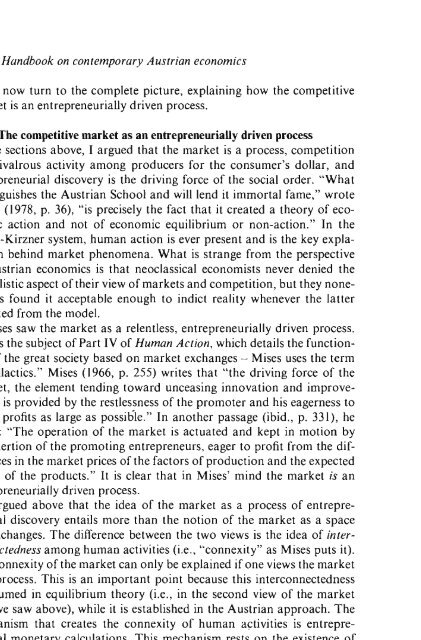Handbook on Contemporary Austrian Economics
Handbook on Contemporary Austrian Economics
Handbook on Contemporary Austrian Economics
Create successful ePaper yourself
Turn your PDF publications into a flip-book with our unique Google optimized e-Paper software.
100 <str<strong>on</strong>g>Handbook</str<strong>on</strong>g> <strong>on</strong> c<strong>on</strong>temporary <strong>Austrian</strong> ec<strong>on</strong>omics<br />
let us now turn to the complete picture, explaining how the competitive<br />
market is an entrepreneurially driven process.<br />
7.5 The competitive market as an entrepreneuriaUy driven process<br />
In the secti<strong>on</strong>s above, I argued that the market is a process, competiti<strong>on</strong><br />
is a rivalrous activity am<strong>on</strong>g producers for the c<strong>on</strong>sumer's dollar, and<br />
entrepreneurial discovery is the driving force of the social order. "What<br />
distinguishes the <strong>Austrian</strong> School and will lend it immortal fame," wrote<br />
Mises (1978, p. 36), "is precisely the fact that it created a theory of ec<strong>on</strong>omic<br />
acti<strong>on</strong> and not of ec<strong>on</strong>omic equilibrium or n<strong>on</strong>-acti<strong>on</strong>." In the<br />
Mises-Kirzner system, human acti<strong>on</strong> is ever present and is the key explanati<strong>on</strong><br />
behind market phenomena. What is strange from the perspective<br />
of <strong>Austrian</strong> ec<strong>on</strong>omics is that neoclassical ec<strong>on</strong>omists never denied the<br />
unrealistic aspect of their view of markets and competiti<strong>on</strong>, but they n<strong>on</strong>etheless<br />
found it acceptable enough to indict reality whenever the latter<br />
deviated from the model.<br />
Mises saw the market as a relentless, entrepreneurially driven process.<br />
This is the subject of Part IV of Human Acti<strong>on</strong>, which details the functi<strong>on</strong>ing<br />
of the great society based <strong>on</strong> market exchanges - Mises uses the term<br />
"catallactics." Mises (1966, p. 255) writes that "the driving force of the<br />
market, the element tending toward unceasing innovati<strong>on</strong> and improvement,<br />
is provided by the restlessness of the promoter and his eagerness to<br />
make profits as large as possible." In another passage (ibid., p. 331), he<br />
states: "The operati<strong>on</strong> of the market is actuated and kept in moti<strong>on</strong> by<br />
the exerti<strong>on</strong> of the promoting entrepreneurs, eager to profit from the differences<br />
in the market prices of the factors of producti<strong>on</strong> and the expected<br />
prices of the products." It is clear that in Mises' mind the market is an<br />
entrepreneurially driven process.<br />
I argued above that the idea of the market as a process of entrepreneurial<br />
discovery entails more than the noti<strong>on</strong> of the market as a space<br />
for exchanges. The difference between the two views is the idea of interc<strong>on</strong>nectedness<br />
am<strong>on</strong>g human activities (i.e., "c<strong>on</strong>nexity" as Mises puts it).<br />
The c<strong>on</strong>nexity of the market can <strong>on</strong>ly be explained if <strong>on</strong>e views the market<br />
as a process. This is an important point because this interc<strong>on</strong>nectedness<br />
is assumed in equilibrium theory (i.e., in the sec<strong>on</strong>d view of the market<br />
that we saw above), while it is established in the <strong>Austrian</strong> approach. The<br />
mechanism that creates the c<strong>on</strong>nexity of human a~tivities is entrepreneurial<br />
m<strong>on</strong>etary calculati<strong>on</strong>s. This mechanism rests <strong>on</strong> the existence of<br />
a medium of exchange and also <strong>on</strong> the n<strong>on</strong>-specificity of labor as a factor<br />
of producti<strong>on</strong>.<br />
As m<strong>on</strong>ey is present in all exchanges and thus links together the decisi<strong>on</strong>s<br />
of every<strong>on</strong>e by virtue of being a medium of exchange, entrepreneurs

















